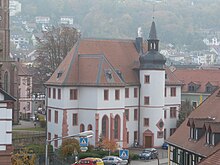Zacharias Ursinus
Zacharias Ursinus (born July 18, 1534 in Breslau ; † March 6, 1583 in Neustadt an der Haardt, today Neustadt an der Weinstrasse ), born as Zacharias Baer , was a Reformed theologian and reformer.
education
His father Kaspar Ursinus, son of the Wiener Neustadt resident Konrad Beer and nephew of the imperial orator Caspar Ursinus Velius , came to Breslau in 1528 after studying in Vienna , where he worked as an educator, then as a preacher and married the patrician daughter Anna Roth. The father had followed a custom of his time and, like his uncle, had Latinized his name. In his youth in Breslau, Zacharias was theologically influenced by Ambrosius Moibanus . Ursinus initially studied at the University of Wittenberg , where he joined Philipp Melanchthon . After a study trip that took him to Geneva to see Johannes Calvin as well as to Paris and Zurich , he initially worked as a teacher at the Elisabeth School in his native city of Wroclaw . After disputes with Lutherans there, he first returned to Reformed Zurich, where he worked closely with Peter Martyr Vermigli and Heinrich Bullinger .
Teaching
University of Heidelberg
On the recommendation of the Zurich theologians, Elector Friedrich III. Who had chosen the reformed confession Ursinus 1561 at the University of Heidelberg , where he a year later a doctorate in theology doctorate was. He taught there for 15 years at the theological faculty and at the Collegium Sapientiae. On behalf of the Elector, he designed templates for the Palatinate Heidelberg Catechism of 1563, probably the most important confession of the Reformed Church in Germany. In several writings he defended the Reformed theology of the Electoral Palatinate against the arguments of the Lutherans.
At the Collegium Sapientiae he continuously interpreted the Heidelberg Catechism for aspiring theologians. From 1584 onwards, students compiled a catechism commentary from transcripts of these lectures, which appeared in various languages and was particularly effective in the Netherlands under the title “Schat-boeck der verklaringen over den Nederlandschen catechismus” ( Treasure Book of Explanations on the Dutch Catechism) .
Casimirianum Neustadt
After the death of Friedrich III. (1576) demanded his son and successor Ludwig VI. by the theologians and preachers of the Electoral Palatinate to swear off the Reformed creed and to sign the formula of concord in favor of Lutheranism . Because Ursinus refused, he had to leave Heidelberg University. He found a new teaching facility at the Casimirianum in Neustadt. He began his activity on April 26, 1578 with a lecture on the prophet Isaiah . In Neustadt he also wrote his last major work, the Admonitio Christiana . The book, published by Guilielmus Antonius (Wilhelm Antonius) in Hanau in 1598 , sees itself as a sharp refutation of the concord formula.
meaning
From the ranks of theological scholars who worked at the Casimirianum, Ursinus stands out in particular, and it is mainly to him that the Casimirianum owes its fame at the time. His Heidelberg catechism is still one of the most important Protestant confessions today . The theologian died in 1583 at the age of only 48 and was buried in the Neustadt collegiate church.
literature
- Ulrich Hutter-Wolandt: URSINUS, Zacharias. In: Biographisch-Bibliographisches Kirchenlexikon (BBKL). Volume 12, Bautz, Herzberg 1997, ISBN 3-88309-068-9 , Sp. 953-960.
- Theodor Julius Ney: Ursinus, Zacharias . In: Allgemeine Deutsche Biographie (ADB). Volume 39, Duncker & Humblot, Leipzig 1895, pp. 369-372.
- Boris Wagner-Peterson: Doctrina schola vitae. Zacharias Ursinus (1534–1583) as interpreter . Refo500 Academic Studies 13. Vandenhoeck & Ruprecht, Göttingen 2013, ISBN 978-3-525-55055-7 (Dissertation University of Heidelberg 2011/12).
- Michael Landgraf : URSINUS tells ... about the time of the Reformation, the Heidelberg Catechism and the questions of life . With illustrations by Steffen Boiselle. Agiro Verlag, Neustadt an der Weinstrasse 2012, ISBN 978-3-939233-05-3 .
Web links
- Literature by and about Zacharias Ursinus in the catalog of the German National Library
- Works by and about Zacharias Ursinus in the German Digital Library
- Digitized works by Zacharias Ursinus
- Herman Hanko: Zacharias Ursinus on cprf.co.uk
Individual evidence
- ^ Johann Georg Müller, Sabine Graumann: The district of Cologne around 1825. Prussian inventory of the country and its population . Böhlau Verlag, Cologne / Weimar 2007, p. 104 ( limited preview in Google Book Search [accessed February 7, 2012]).
- ↑ a b Theologische Realenzyklopädie , Volume 34, edited by Gerhard Müller, Walter de Gruyter, Berlin / New York 2002, p. 445.
- ↑ Kulturportal West-Ost, Ursinus (Beer, Bär), Zacharias , accessed on October 10, 2015.
- ↑ Boris Wagner-Peterson: Zacharias Ursinus and “his” interpretation of the Heidelberg Catechism . In: Matthias Freudenberg, J. Marius J. Lange van Ravenswaay (ed.): History and effects of the Heidelberg Catechism . Neukirchener Theologie, Neukirchen-Vluyn 2013, ISBN 978-3-7887-2738-3 , p. 86-109 .
- ^ Martin Ernst Hirzel, Frank Mathwig, Matthias Zeindler (eds.): The Heidelberg Catechism, a reformed key text . TVZ, Zurich 2013, ISBN 978-3-290-17709-6 , pp. 13 (introduction) .
| personal data | |
|---|---|
| SURNAME | Ursinus, Zacharias |
| ALTERNATIVE NAMES | Bear, Zacharias; Ursinus, Zacharius |
| BRIEF DESCRIPTION | German reformed theologian |
| DATE OF BIRTH | July 18, 1534 |
| PLACE OF BIRTH | Wroclaw |
| DATE OF DEATH | March 6, 1583 |
| Place of death | Neustadt an der Weinstrasse |



